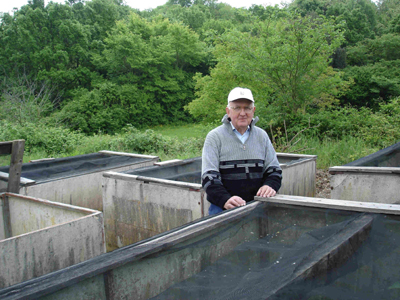


Leslie Elmslie died in Rome in November 2007. He was a familiar person at malacological congresses, and good company, but few malacologists knew much of his life beyond his interest in snail farming.His sister, Heather Kotake, has kindly provided the following notes. After reading them, many malacologists will, like me, wish that they had known him better, and we extend to her our deepest sympathies.Bill Bailey
Leslie standing at his snail pens at his house in Bassano Romano
Leslie was born on 9th June, 1935.When he won an Exhibition to Christ's College, Cambridge (our father's old college), the family assumed that he would follow in his father's footsteps and study Classics, but Leslie chose to return to the family's rural roots, and opted to study Agriculture.After graduation in the mid-1950s, he settled on a farm in Lazonby, near Penrith.It was a mixed farm of 100 acres, with poultry and agricultural land.However, it turned out to be just too large for one person to run and yet not large enough for him to take on a partner, so he was obliged to give up the farm and work with Thornbers, a major poultry company at Hebden Bridge in Yorkshire, with whom he had had frequent dealings while on the farm, and conducted for them various experiments on the better breeding of poultry.In due course they sent him to Aba in the south-east of Nigeria (later Biafra), to advise a local man, Augustine Meniru, who was trying to set up a poultry-breeding business.While there, Leslie developed other interests of his own, which included the cultivation and uses of plantain (which he described as "a sort of vegetable banana"), and inaugurated an academic society for their study.He also became involved in a modem cattle-rearing venture in the north of the area.
The outbreak of the Biafran War interrupted all this, and he had finally to escape by crossing the Niger River by canoe in the dead of night. He also managed to get out the two elder children of his partner Augustine Meniru, a girl and a boy, then aged about 10 and 8, and consigned them to the care of our mother in Edinburgh until it was safe for them to return.(The boy later married an English girl, who had been in VSO, and they now live in Bedford.He still calls him "Uncle Leslie".)
Leslie went back to Thornbers until the end of hostilities, before returning to Nigeria, but the new government’s policies made it impossible for him to retrieve his investment in the country. In addition he suffered from blackwater fever (a complication of malaria). His doctors told him that the climate of Nigeria would be fatal for him, and that the climate of Britain was too cold and damp.So, forced to abandon all he had, he chose to move to Italy, to Rome.There he supported himself at first by teaching English, in the Pontifical Gregorian University and elsewhere, and then, increasingly, by translation.He also did work on contract for the FAO.It was as a result of this work that his interest was aroused in snails, and he edited several volumes of the Italian Helicicultural Society’s symposia ‘Snail Farming Research’. He cultivated snails on a little estate that he bought in Bassano Romano, near Viterbo, in the Etruscan country north-west of Rome.There he conducted various experiments, initially under the auspices of the FAO, then later on his own.These were not without problems.Some of the snails kept mysteriously disappearing during the week, while Leslie was in Rome.It turned out that a Town Councillor was stealing them, presumably to sell. Leslie threatened him with the legal might of the FAO for interfering with FAO experiments.The thefts ceased.
In 1994 he was contacted by Dr. Tzvetan Tsekov, of Sofia in Bulgaria, for advice on the commercial cultivation of snails. They built a pilot farm for snails and Leslie, on visits four or five times a year, investigated the development of Bulgarian snails in artificial conditions and at the same time taught them how to breed snails. Leslie had friends on all continents, corresponding and exchanging breeding stock. In his later years he actively investigated snails from a region of Bulgaria with a paler flesh than normal.Leslie visited Japan many times, where Ihad married a Japanese mathematician.His insatiable curiosity led him to travel all over the country, visiting places that few Japanese have heard of.
Leslie died in Rome of a cerebral haemorrhage on 15th November 2007. He went into his coffin wearing his yellow "snail" tie, of which he was very fond. His ashes were interred in his parents' grave in The Grange Cemetery, Edinburgh, on 26th March 2008.At about the same time in the town of Koprivshtitsa inBulgaria, a town which had become almost a second home to him, the Mayor dedicated a memorial plaque in what they are calling Leslie's Garden.It is "a green place with flowers, of 130 square metres, along the river, situated near the historic bridge on the main tourist road."Leslie had donated €7,500 for its preservation and upkeep when he heard that it was to be sold for development.
His last communication with me was the day before his first cerebral haemorrhage, discussing details of his planned visit to me in December. I will miss him.
Heather Kotake
Leslie standing at his snail pens at his house in Bassano Romano